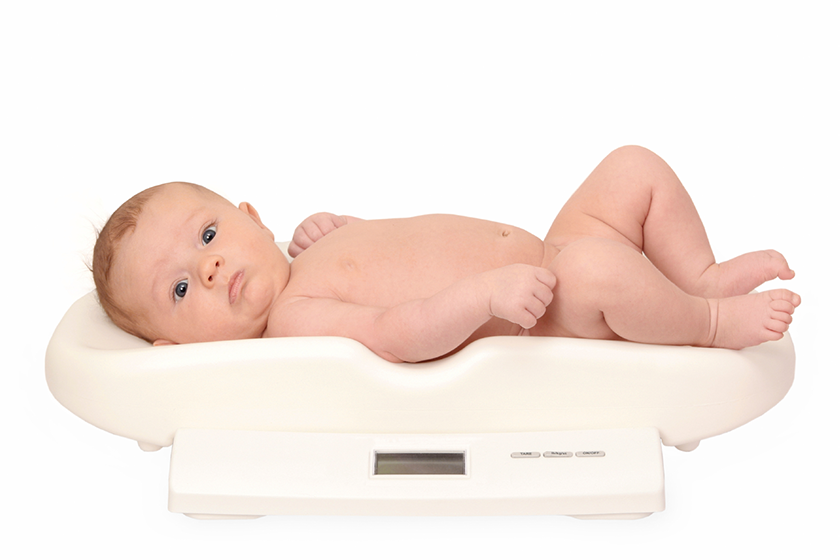Is my baby getting enough to eat?

View as slideshow
Am I making enough milk?
How much milk a mother makes depends on how much milk her baby needs. But rest assured that nearly every mother makes just the right amount at just the right time to satisfy her baby’s needs. Mothers are often surprised to see how quickly their milk supply increases during the first 3–5 days after birth. What may seem like small amounts of milk at first turns out to be exactly what newborn babies need. Frequent feedings (8 to 12 times in each 24-hour period) ensures that each mother’s milk supply matches the needs of her growing baby. Click through for signs your baby is getting enough to eat.

Your baby is active & alert
Babies that are well fed will be active and alert. Although newborns generally sleep 16-18 hours each day, unusual sleepiness may be an indication that your baby is underfed. If you’re having trouble waking your baby to eat or keeping your baby awake at the breast, try applying a cool, damp cloth to your baby’s forehead and face. Tickling your baby’s feet may help as well.

Your baby is satisfied
A well-fed baby will appear happy and satisfied after a feeding (maybe even grinning as he releases the breast!). If your baby is restless and fussy after a feeding, chances are he is still hungry. Check your baby’s latch and consider switching to another breastfeeding position.

Your baby breastfeeds at least 8 times a day
Newborns typically feed 8 to 12 times in a 24-hour period. Every baby is different but you should be sure your baby is feeding a minimum of eight times a day. Feeding times may vary from baby to baby. Some babies breastfeed every 1-3 hours for 10-15 minutes on each breast; others breastfeed 30-45 minutes on one breast only; and some breastfeed 15 minutes out of each hour for 4 or 5 feedings and then sleep for 4 or 5 hours.
Regardless of the length of each feeding, after several minutes into a feeding, your baby starts receiving hindmilk, which is thick and creamy and high in protein, fat, and calories. Hindmilk satisfies your baby’s hunger and helps your baby gain weight. You will know your baby is feeding well if you hear him suck and swallow repeatedly while breastfeeding.

Your baby poops early & often
You can be sure that your baby is feeding well if he has three or more stools a day after day 1, increasing to four or more stools a day after day 5. A stool is a stain at least the size of your baby’s first, or one or more teaspoons of solid material. During the first days after birth, newborns pass meconium (a thick, tarry, black material that fills the baby’s lower bowel). By day 5, your baby’s stool should change from black (or dark green) to yellow.
Click here for more scoop on poop.

Your baby’s pee is clear or pale yellow
Your baby should have clear or pale yellow urine, and six or more wet diapers a day by day 5. Pale-colored urine shows that your baby is well-hydrated. Dark urine suggests that your baby may not be getting enough to drink.

Your baby gains weight after day 5
Most babies lose an average of 5–7 percent of their birth weight during the first 5 days. If your baby loses more than 7 percent, it may indicate that she is not getting enough to eat. Talk to your baby’s health care provider about possible solutions, including helping your baby achieve a better latch and helping you improve your milk supply.
By day 10, most healthy babies who are born full term (38–40 weeks gestation) will have regained any lost weight and returned to (or possibly exceeded) their birth weight.

Your baby gains 4–8 ounces each week
After 10 days of birth (or when a baby has gained back his birth weight), babies typically gain 4–8 ounces a week. Healthy babies who are born full term often double their birth weight by 4–6 months of age and triple their birth weight by one year of age. At well baby visits, your baby’s health care provider will measure your baby’s weight, length, and head circumference and chart it on a growth curve.
In the past, these growth charts were based on weight gain patterns common to formula-fed babies. More recently, the Centers for Disease Control and Prevention (CDC) released a statement recommending that health care providers use the World Health Organization (WHO) growth charts for any baby under 24 months of age.

How many ounces will my baby drink a day?
If you’re a mother who has been breastfeeding on request, you probably haven’t had to collect and store breast milk. But if circumstances, such as returning to work or school, require that you be away from your baby, it can be a bit daunting to figure out how much milk you need to have available each day to ensure that your baby gets the ongoing benefits of human milk.
Exclusively breastfed babies drink on average 25 oz (750 mL) per day between the ages of 1 month and 6 months. While intake can vary depending on your baby’s age and weight, milk intake typically ranges from 19-30 oz per day (570-900 mL per day).
Begin by storing your milk in small quantities, about two ounces each. This strategy helps you reduce waste (it is best to discard whatever breast milk remains in a bottle once thawed and offered to your baby, although some caregivers use the leftover milk to complete the feeding if it was interrupted) while you are figuring out how much milk your baby needs. Ask your child’s caregiver to keep a log of feeding times and amounts for the first week or two. Based on this information, you can determine whether you want to stick with two-ounce servings or move to larger amounts.
Because the composition of your milk changes to meet your growing baby’s needs, the amount of milk your baby consumes during the first 6 months usually remains relatively stable. You may find that your baby takes less of your expressed milk during the day, and prefers to breastfeed more often in the mornings and at night when you are together. However, an increase in your baby’s demand for milk during the day could indicate that the caregiver is overfeeding her.
Once your baby starts solid foods (around 6 months of age), the amount of milk she consumes will probably decrease, but breast milk should still be an important part of her diet for at least the first year.